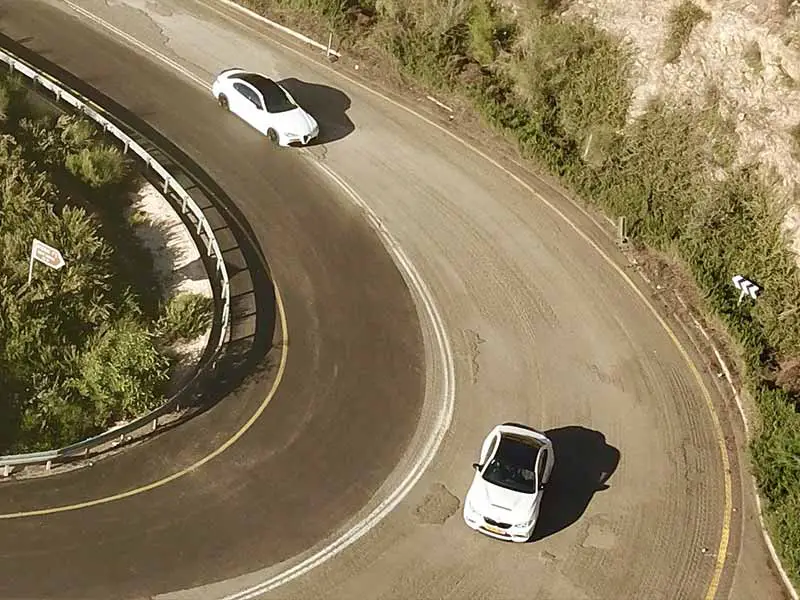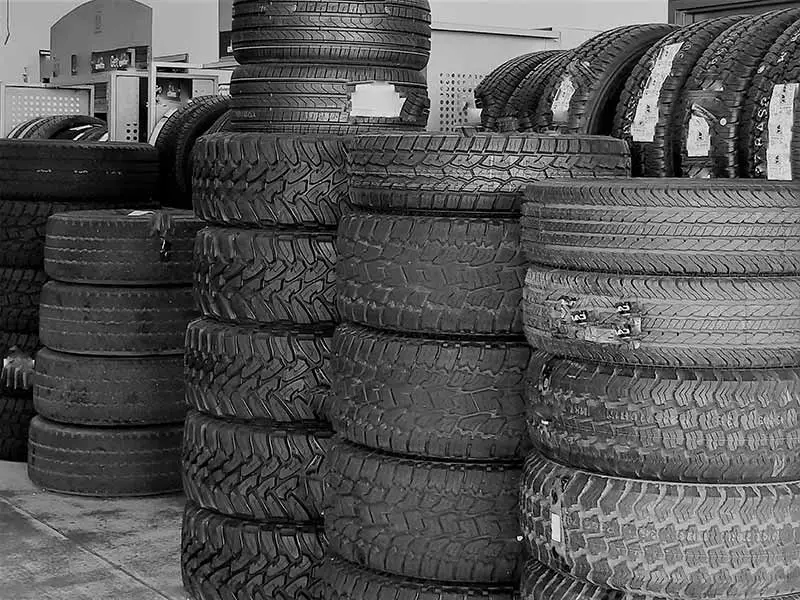Did you know the tires on your car play a huge role in how it handles, rides, and even how much fuel it consumes? If you’ve ever been curious about what makes radial tires so popular and how they compare to non-radial options, you’re in the right place!
What Is A Radial Tire?
A radial tire is a type of tire construction that has cords running perpendicular to the direction of travel, which enhances handling, ride comfort, and fuel efficiency.
In this article, we’ll dive deep into the world of radial tires, discussing their history, how they’re constructed, and how they differ from non-radial tires. We’ll also provide a comprehensive guide to the types of radial tires, how to identify them, and the key differences between radial and non-radial tires.
Let’s take a closer look.

Are All Modern Tires Radial?
In the early days of the automobile, the most common type of tire was the bias-ply or cross-ply tire. These tires featured a design where the cords inside the tire were laid diagonally across each other, creating a crisscross pattern. Although bias-ply tires were great for their time, they had some limitations, such as poor handling and heat buildup.
Enter radial tires. Invented in 1946, radial tires quickly gained popularity due to their improved performance and longevity. The major difference between radial and bias-ply tires lies in their construction. Radial tires have cords that run perpendicular to the direction of travel, which helps reduce heat buildup and improve fuel efficiency.
Radial vs. Non-Radial Tires: Popularity and Usage
Today, radial tires dominate the market, especially for passenger cars and trucks. Most vehicles come standard with radial tires due to their numerous advantages over non-radial tires. However, non-radial tires are still in use in some situations. For example:
- Off-road vehicles: Bias-ply tires can be a better choice for off-road use because of their sturdier sidewalls, which provide better resistance to punctures and impacts.
- Classic cars: Owners of vintage automobiles often prefer bias-ply tires to maintain the vehicle’s original appearance and handling characteristics.
- Heavy-duty vehicles: Some heavy trucks and buses may use non-radial tires due to their unique handling and load-carrying requirements.
The Origin of the Term “Radial Tire”
The term “radial” comes from the way the cords are arranged within the tire. This construction is what sets radial tires apart from non-radial or bias-ply tires.
Radial Tire Construction: The Role of Cords
Tires consist of multiple layers of materials, including rubber, fabric, and sometimes steel. Among these layers, you’ll find cords or plies, which are made from materials like polyester, nylon, or steel. These cords play a crucial role in providing strength and stability to the tire, allowing it to maintain its shape and carry the vehicle’s weight.
In radial tires, these cords are placed in a unique pattern that provides various benefits. Let’s take a closer look:
- Perpendicular arrangement: The cords in a radial tire run at a 90-degree angle to the direction of travel. This arrangement is different from bias-ply tires, where cords crisscross diagonally.
- Crown and sidewall separation: Radial tire construction separates the crown (the tire’s main contact area with the road) from the sidewalls, allowing each part to perform its specific function independently. This separation results in improved handling and a smoother ride.
Benefits of Radial Tire Construction
The distinctive construction of radial tires offers several advantages over traditional bias-ply tires:
- Heat reduction: The perpendicular arrangement of cords in radial tires helps reduce heat buildup, which can lead to longer tire life and better fuel efficiency.
- Improved handling: The independent performance of the crown and sidewalls in radial tires provides better road contact and steering responsiveness, leading to enhanced handling and stability.
- Increased ride comfort: Radial tires can absorb more road irregularities, making for a smoother and more comfortable ride compared to bias-ply tires.

Types of Radial Tires: Belted and Non-Belted
As you explore the world of radial tires, you’ll find that there are two main types: belted and non-belted. These categories refer to the presence (or absence) of an additional layer of reinforcement within the tire. Let’s take a closer look at each type and compare their differences.
Belted Radial Tires
Belted radial tires are designed with an extra layer of reinforcement called a belt that is placed between the tread and the cords. This belt is typically made of steel, fiberglass, or Kevlar, and serves several purposes:
- Tread stability: The belt helps maintain the tire’s shape and keeps the tread flat on the road, improving traction and handling.
- Puncture resistance: The belt adds an extra layer of protection against punctures and road hazards.
- Longer tire life: By providing additional support to the tread, the belt can extend the life of the tire.
Most modern radial tires for passenger cars and trucks are belted because of these advantages.
Non-Belted Radial Tires
Non-belted radial tires lack the additional reinforcement layer found in belted radial tires. While they still have cords running radially, they don’t provide the same level of tread stability, puncture resistance, or longevity as their belted counterparts. However, non-belted radial tires can offer some benefits:
- Lower cost: Non-belted radial tires are typically less expensive to produce than belted radial tires, making them more budget-friendly.
- Lighter weight: Without the extra reinforcement layer, non-belted radial tires are lighter than belted radial tires, which can improve fuel efficiency.
Comparison Between Belted and Non-Belted Radial Tires
When choosing between belted and non-belted radial tires, it’s essential to consider the trade-offs:
- Performance vs. cost: While belted radial tires offer better performance and durability, they can also be more expensive. Non-belted radial tires, on the other hand, are more budget-friendly but may not provide the same level of performance or longevity.
- Fuel efficiency vs. stability: The lighter weight of non-belted radial tires can improve fuel efficiency, but this comes at the expense of tread stability and puncture resistance provided by the belt in belted radial tires.
Non-Radial Tires: An Alternative to Radial Tires
While radial tires are the most popular choice for modern passenger cars and trucks, non-radial tires still have their place in the automotive world. In this section, we’ll explore the characteristics of non-radial tires, common types, and some reasons why you might choose them over radial tires.
Definition and Characteristics of Non-Radial Tires
Non-radial tires, also known as bias-ply or cross-ply tires, have a different construction than radial tires. In non-radial tires, the cords are laid diagonally across each other, creating a crisscross pattern. This construction results in the following characteristics:
- Less flexibility: Non-radial tires have stiffer sidewalls compared to radial tires, which can affect ride comfort.
- Increased heat buildup: The crisscross arrangement of cords in non-radial tires generates more heat, which can lead to reduced tire life and lower fuel efficiency.
- Reduced handling capabilities: Non-radial tires typically have less road contact and reduced steering responsiveness compared to radial tires.
Common Types of Non-Radial Tires
The most prevalent type of non-radial tire is the bias-ply or cross-ply tire, which we’ve already mentioned. However, there are other types of non-radial tires, such as:
- Bias belted tires: These tires feature a diagonal cord arrangement similar to bias-ply tires, but with an additional reinforcement layer (or belt) beneath the tread. Bias belted tires offer some of the benefits of belted radial tires, like improved tread stability and puncture resistance, but still maintain the characteristics of non-radial tires.
Reasons to Choose Non-Radial Tires Over Radial Tires
Despite their disadvantages, there are a few situations where non-radial tires might be the better choice:
- Off-road performance: Non-radial tires often have thicker and more durable sidewalls, making them better suited for off-road conditions where punctures and impacts are more likely.
- Classic car authenticity: If you’re restoring a vintage vehicle, using non-radial tires can help maintain the original look and feel of the car.
- Specific load-carrying requirements: Some heavy-duty trucks and buses may benefit from non-radial tires due to their unique load-carrying and handling needs.
Identifying Radial Tires
As a tire expert, it’s important to know how to identify whether a tire is radial or non-radial, especially when it comes to making the right choice for your vehicle. In this section, we’ll discuss the markings and symbols you can look for on your tires, and why understanding tire codes is crucial.
Markings and Symbols on Tires
Tire sidewalls contain a wealth of information in the form of codes and markings. These codes reveal essential details about the tire, such as its size, load-carrying capacity, speed rating, and type. To determine if a tire is radial or not, look for the following markings:
- “R” symbol: The letter “R” in the tire code indicates that the tire is a radial tire. For example, a tire size marking of “P215/65R15” tells you that the tire is a radial tire with a width of 215 millimeters, an aspect ratio of 65, and fits a 15-inch rim.
- Absence of “R” symbol: If the tire code does not have the “R” symbol, it’s likely a non-radial or bias-ply tire. For instance, a tire size marking of “7.50-16” is a non-radial tire with a width of 7.50 inches and fits a 16-inch rim.
By examining the tire markings, you can quickly identify if your tires are radial or not.
Importance of Understanding Tire Codes
Being able to decipher tire codes is vital for several reasons:
- Proper tire selection: Knowing how to read tire codes can help you choose the right type, size, and performance characteristics for your vehicle, ensuring optimal safety and performance.
- Tire maintenance: Understanding tire codes can also help with routine maintenance tasks, such as determining when it’s time to replace your tires or how much air pressure they require.
- Legal compliance: In some regions, there may be specific requirements or restrictions regarding tire types and sizes. Being familiar with tire codes can help you stay compliant with local regulations.

Radial vs. Non-Radial Tires: Key Differences
As an expert on tires, it’s crucial to understand the differences between radial and non-radial tires, as well as their respective advantages and disadvantages. In this section, we’ll provide a comprehensive comparison between these two types of tires and discuss the factors that might influence your choice.
Construction Differences
The primary distinction between radial and non-radial tires lies in their internal construction, particularly the arrangement of cords:
- Radial tires: In radial tires, the cords run perpendicular to the direction of travel, which reduces heat buildup and enables the tire’s crown and sidewalls to perform independently.
- Non-radial tires: In non-radial or bias-ply tires, the cords are laid diagonally across each other, creating a crisscross pattern. This construction leads to stiffer sidewalls and increased heat buildup.
Performance Differences
The unique construction of radial and non-radial tires leads to several performance differences:
- Handling: Radial tires generally provide better handling due to their improved road contact and steering responsiveness.
- Ride comfort: Radial tires offer a smoother and more comfortable ride because of their greater flexibility and ability to absorb road irregularities.
- Tire life: Radial tires tend to have a longer lifespan due to their reduced heat buildup and more even tread wear.
- Fuel efficiency: Radial tires can also improve fuel efficiency, thanks to their lower rolling resistance.
Choosing Between Radial and Non-Radial Tires
When deciding between radial and non-radial tires, consider the following factors:
- Vehicle type: Most modern passenger cars and trucks come standard with radial tires, which offer better overall performance. However, certain vehicles, such as off-road vehicles or classic cars, might benefit from non-radial tires.
- Driving conditions: Radial tires are well-suited for typical road conditions, while non-radial tires might be preferable in specific situations, like off-road driving or heavy-duty applications.
- Budget: Radial tires can be more expensive than non-radial tires, so consider your budget when making a decision.

The Pros and Cons of Radial Tires
Now that we have explored the key differences between radial and non-radial tires, let’s take a closer look at the advantages and disadvantages of radial tires. As a tire expert, it’s important to have a comprehensive understanding of the pros and cons of radial tires to make informed recommendations and decisions.
Pros of Radial Tires
Radial tires offer several benefits over non-radial tires, which make them the preferred choice for most modern passenger cars and trucks:
- Improved handling: The independent performance of the crown and sidewalls in radial tires provides better road contact and steering responsiveness, resulting in enhanced handling and stability.
- Smoother ride: The flexibility of radial tires allows them to better absorb road irregularities, leading to a more comfortable and smoother ride.
- Longer tire life: The reduced heat buildup in radial tires contributes to longer tire life and more even tread wear.
- Fuel efficiency: Radial tires have lower rolling resistance, which can lead to better fuel efficiency for your vehicle.
- Puncture resistance (belted radial tires): The additional reinforcement layer in belted radial tires offers increased puncture resistance and protection against road hazards.
Cons of Radial Tires
Despite their numerous benefits, radial tires also have some drawbacks:
- Higher cost: Radial tires can be more expensive to purchase than non-radial tires, which may be a concern for budget-conscious drivers.
- Sidewall vulnerability (non-belted radial tires): Non-belted radial tires may have more vulnerable sidewalls compared to their belted counterparts, making them less resistant to punctures or other damage.
- Less suited for off-road conditions: While radial tires are great for typical road conditions, they may not be as well-suited for off-road driving, where non-radial tires with sturdier sidewalls might be preferable.
Resources
Below are some links you may find helpful when learning about tires
- Advantages and disadvantages of radial tires – Cars Direct
- What are radial tires and how do they work? – GetJerry.com
Final Thoughts
The key takeaway from this article is that radial tires are generally superior in terms of handling, ride comfort, fuel efficiency, and tire life, making them the top choice for most modern passenger cars and trucks. However, there are specific situations where non-radial tires might be more appropriate.
We’ll leave you with this thought-provoking insight: “The only thing between you and the road is your tires. Choose wisely, because your safety and driving experience depend on it.”
Good luck and happy motoring.




